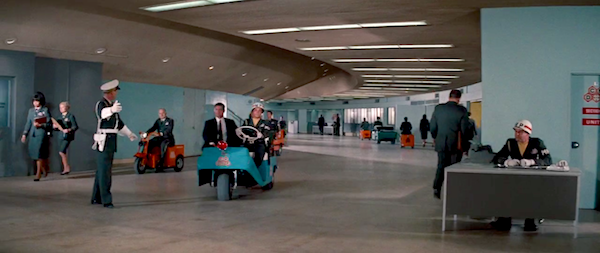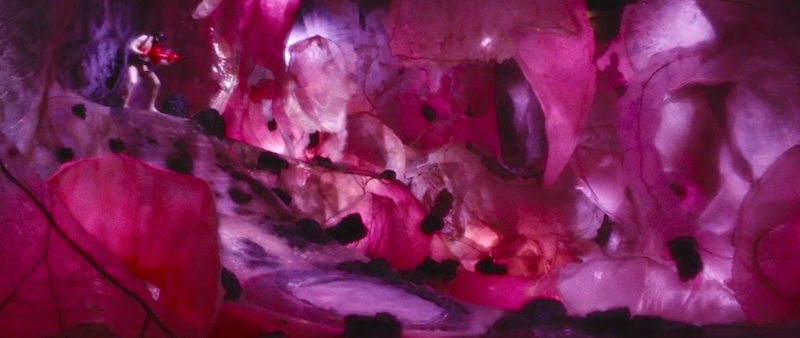"The Furniture" is our weekly series on Production Design. Here's Daniel Walber...
 This week marks the 50th anniversary of Richard Fleischer’s Fantastic Voyage, as absurd and beautiful a film as Hollywood has ever made. It’s also a testament to what live action science fiction used to be like, before digital technology gave directors the tools to make every fantasy look realistic.
This week marks the 50th anniversary of Richard Fleischer’s Fantastic Voyage, as absurd and beautiful a film as Hollywood has ever made. It’s also a testament to what live action science fiction used to be like, before digital technology gave directors the tools to make every fantasy look realistic.
Inspired by the arms races of the Cold War, it chronicles a submarine trip into the tumorous brain of a brilliant scientist. The mission is to eliminate his cancer with a tiny laser, save his life, and preserve his miniaturization knowledge for the USA. It’s utterly ridiculous. Isaac Asimov, alarmed by the script’s plot holes, demanded the right to fix all of its problems for his novelization.
Of course, that might classify him as a bit of a fuddy-duddy. Trips into the body wouldn’t be nearly as much fun if they were realistic. If anything, they’d probably gross out the audience.

Pixar understood this, creating an entirely new organ system for Inside Out. Fleischer’s team for Fantastic Voyage also prioritized the striking over the reasonable.
Much of this success is, of course, due to the production design...
Art directors Dale Hennesy (Logan’s Run) and Jack Martin Smith (Cleopatra) and set decorators Stuart Reiss (Doctor Dolittle) and Walter Scott (The King and I) set the tone even before the miniaturization. The underground base of the Combined Miniaturized Deterrent Forces, or C.M.D.F., look less like the Pentagon and more like a James Bond film.

Then the Proteus is introduced, in a shrinking sequence that predicts Willy Wonka & The Chocolate Factory. It was designed by Harper Goff, who was also responsible for the Nautilus in Fleischer’s 20,000 Leagues Under the Sea.
It is then injected into the bloodstream of the unconscious Dr. Benes. The mission commanders follow along with this charmingly oversized chart.

But the real design fun begins inside. There are three sets within the body of Dr. Benes, each of them quite distinctive. The first is the lungs, a pit stop where the team hopes to refill their suspiciously drained oxygen tank. Agent Charles Grant (Stephen Boyd) steps into the bloodstream with a hose and pops through the membrane into the lungs.
The set is bright pink and cavernous, coinciding with the whipping wind on the soundtrack. On the one hand, the space dwarfs Grant and threatens to toss him irrevocably away from the Proteus. On the other, the paper-like thinness of the pink walls threatens to tear out beneath him, a disaster for both the expedition and the man in which it proceeds.

Next is the ear, where the Proteus is forced to pause en route to the brain. Any noise in the outside room could have the impact of an earthquake. Yet the crew has to venture out and peel the seaweed-like antibodies off of the vents before they can keep moving.
The patterns on the wall are unsettling, and the small ledge on which the Proteus sits is no more reassuring. The colors are cool, and the vessel never looks more like a spaceship lost in the nether-regions of the galaxy.

They make it out, though, and reach their final destination. The brain is calm and pale, its circular markings and web-like walls evoking the same sort of magic as Michael Powell’s Duke Bluebeard’s Castle.

The colors are cold and deep, mimicking a gradual move over the course of the whole film from the warm reds of the arteries to the blues of the veins and the frigid palette of the ear and brain. These peaceful halls seem to go on forever, offering a lull in spite of the urgent ticking down of the clock.

Now, one could totally remake Fantastic Voyage with a philosophy of realism and precision. James Cameron has long wanted the project, and one can only guess how research-oriented his approach might be. But he’s off in Avatar-land. In January, it was reported that the property had been handed over to Guillermo del Toro. If there’s anyone who understands the need for a departure from biological reality, it’s that guy. My fingers are crossed.

Other sci-fi or surreal highlights from "The Furniture"...
The Lobster, The Spy Who Loved Me, The Wonderful World of the Brothers Grimm, Batman